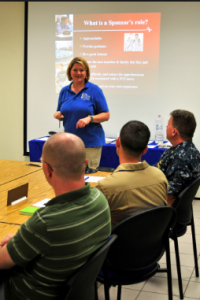Employee Onboarding Orientation and First Day tips for the employee.
PRESENTED BY PAYSTUBMAKR.COM
On-boarding Wikipedia
Onboarding, also known as organizational socialization, refers to the mechanism through which new employees acquire the necessary knowledge, skills, and behaviors in order to become effective organizational members and insiders.[1]
It is the process of integrating a new employee into the organization and its culture.[2] Tactics used in this process include formal meetings, lectures, videos, printed materials, or computer-based orientations to introduce newcomers to their new jobs and organizations. Research has demonstrated that these socialization techniques lead to positive outcomes for new employees such as higher job satisfaction, better job performance, greater organizational commitment, and reduction in occupational stress and intent to quit. These outcomes are particularly important to an organization looking to retain a competitive advantage in an increasingly mobile and globalized workforce. In the United States, for example, up to 25% of workers are organizational newcomers engaged in an onboarding process.[6] The term induction is used instead in regions such as Australia, New Zealand, Canada, and parts of Europe.[7] This is known in some parts of the world as training.

New employees orientation
New employees hiring is not yet having new employees producing and achieving goals. You need an adjustment and onboarding program before you can count on the hired staff. A good orientation process will shorten the time between the first day to the day the employees are already working on full steam. The goal of the orientation is to make the new employees feel welcomed and integrated into the workplace as fast as possible.
Companies have a package of information, starting with employee handbook continuing with technical details and procedure manuals. Any employee level should have its package with particular information and instruction. New employee orientation will start with a meeting with an HR manager that will have the following topics:
-
Safety roles and related information.
-
The practical environmental instructions.
-
The description of your job.
-
The list of benefits and benefits eligibility.
-
The employee’s team including the manager and coworkers.
-
Description of the company culture
-
Company history
-
The organizational chart
-
Anything else relevant for a new employee to know for working in the new company
New employee orientation will include a tour in all the departments of the workplace and meeting the employees that are essential to the new worker success. Remember to schedule this meeting before the arrival of your new employee.

On-boarding of the new workforce should include training by a fellow worker that know the job or the one that used to do the same work. Some employers will send new people to learn how the other department work is done. By doing this broad training, they give newcomers the perspective of the whole operation.
Some organizations spread the orientation in two or three months by taking every day a short time for the orientation after the regular work is already done.
This longtime orientation will include training of the use of the different machinery up to the meeting with the CEO. At the end of the orientation, the employee will have knowledge of the organization’s operation, history, culture, values, and mission.
Give your new employees training and time to get used and absorb your workplace knowledge and socially immersed with the workforce.
On-boarding has to edges the workplace and the worker.
We will have some tips for the employee to make his or her side in the process, especially the employee first steps in the first days of a new job.
The best novice employee direction:
-
has goals and meets them
-
makes the first day a celebration
-
involves co-workers and families
-
makes new workers productive immediately
-
is not dull
-
uses new workers reviews
Interested in learning more about new employee orientation or employee onboarding? You will find additional information using these resources.
How to succeed on your first day at the new workplace
-
-
Dress the part. You do not want to appear with the un-adequate dress in your first day at the new workplace, make sure that you know what are the rules in the company, reading the handbook or checking on the website will give you an idea about how they dress in your new job.
-
-
-
Plan your commute, Check up the route to work and parking lot space. Or the buss and tren options and schedules.
-
-
-
Be ready to work or not. Your new company can give you a lot of reading to do before starting the real work. Your new supervisor could make another way will throw you into the fire with something hard or big enough to give you to sweat a little bit. You have to be ready to resolve problems by yourself to show your capacity.
-
-
-
Being friendly will be your most important action after work itself. Your relationship with your co-worker is crucial for your onboarding and all your life in the workplace you just started working. Be open talking with your new colleagues; basic politeness will do a great deal for you. You need their help now and you will need to be happy at your workplace having a good relationship with the managers, and the workers will be good for work and after work life.
-
-
-
Remember names; people react differently when you call them by their name. Make yourself remember the names as fast as possible. There are lots of little tricks out there, make use of it and use the names of your colleagues.
-
-
-
Accept that lunch invitation, you can expect that your new co-workers will invite you to go to lunch. Going to lunch with your colleagues will develop a closer relationship that will make a stronger bond within the workforce.

-
-
-
Know the company’s recent successes, take some time to learn what is going in the company. Learn about the success stories. Knowing about your work will help you with your colleagues and managers. Showing that you took the time to learn about their company will be taken as a compliment by your co-worker.
-
-
-
Find out who you’ll be working with the most. From minute one, you have to see who are your closest co-workers, those that you will be working on a daily bases. Employees that you will need to cooperate with them on every day in every piece of work that you have. Or in solving together problems. Make sure that you remember their names and what is their exact role in the process.
paystumbmakr.com team thanks you for a visit and reading this blog

Disclaimer: John Wolf and paystubmakr.com are making a total effort to offer accurate, good, ethical HR management, employer, and workplace advice. We do not use the words of an attorney and the content on the site is not given as legal advice. The website has readers from all US states which all have different laws on these topics. The reader should look for legal advice before taking any action. The information presented on this website is offered as a general guide only and never as legal advice.
-


